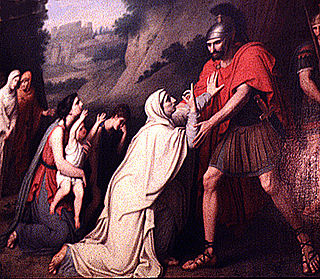Related Research Articles
This article concerns the period 219 BC – 210 BC.

Gaius MarciusCoriolanus was a Roman general who is said to have lived in the 5th century BC. He received his toponymic cognomen "Coriolanus" because of his exceptional valor in a Roman siege of the Volscian city of Corioli. He was subsequently exiled from Rome, and led troops of Rome's enemy the Volsci to besiege the city.

Year 216 BC was a year of the pre-Julian Roman calendar. At the time it was known as the Year of the Consulship of Varro and Paullus. The denomination 216 BC for this year has been used since the early medieval period, when the Anno Domini calendar era became the prevalent method in Europe for naming years.

Lucius Junius Brutus is the semi-legendary founder of the Roman Republic, and traditionally one of its first consuls in 509 BC. He was reputedly responsible for the expulsion of his uncle the Roman king Tarquinius Superbus after the suicide of Lucretia, which led to the overthrow of the Roman monarchy. He was involved in the abdication of fellow consul Tarquinius Collatinus, and executed two of his sons for plotting the restoration of the Tarquins.
The gens Baebia was a plebeian family in ancient Rome. The first member of the gens who obtained the consulship was Gnaeus Baebius Tamphilus, in 182 BC. During the later Republic, the Baebii were frequently connected with the patrician family of the Aemilii.

Lars Porsena was an Etruscan king known for his war against the city of Rome. He ruled over the city of Clusium. There are no established dates for his rule, but Roman sources often place the war at around 508 BC.
Agrarian laws were laws among the Romans regulating the division of the public lands, or ager publicus. In its broader definition, it can also refer to the agricultural laws relating to peasants and husbandmen, or to the general farming class of people of any society.

Publius Valerius Poplicola or Publicola was one of four Roman aristocrats who led the overthrow of the monarchy, and became a Roman consul, the colleague of Lucius Junius Brutus in 509 BC, traditionally considered the first year of the Roman Republic.

The Battle of Numistro was fought in 210 BC between Hannibal's army and one of the Roman consular armies led by consul Marcus Claudius Marcellus. It was the fourth time they met in a battle. Previous encounters were located around the walls of Nola (Campania) in 216, 215, and 214 and had been favourable for the Roman side.
Publius Aelius Paetus was a Roman consul of the late 3rd century BC. He was a prominent supporter and ally of Scipio Africanus, and was elected censor with Africanus in 199.
The Roman–Etruscan Wars were a series of wars fought between ancient Rome and the Etruscans. Information about many of the wars is limited, particularly those in the early parts of Rome's history, and in large part is known from ancient texts alone. The conquest of Etruria was completed in 265–264 BC.
Gnaeus Manlius Vulso was Roman consul in 474 BC with Lucius Furius Medullinus Fusus.
Titus was the eldest son of Lucius Tarquinius Superbus, the last king of Rome. During his father's reign, he accompanied his younger brother Aruns and his cousin Lucius Junius Brutus to consult the Oracle at Delphi to have interpreted an omen witnessed by the king.
The Tarquinian conspiracy was a conspiracy amongst a number of senators and leading men of ancient Rome in 509 BC to reinstate the monarchy, and to put Lucius Tarquinius Superbus back on the throne. The conspirators were discovered and executed. The story is part of Rome's early semi-legendary history.
The gens Laetoria was a plebeian family at ancient Rome. Its members appear regularly throughout the history of the Republic. None of the Laetorii ever obtained the consulship, but several achieved lesser offices of the Roman state.
Marcus Fabius Vibulanus was consul of the Roman republic in 483 and 480 BC.
Aulus Manlius Vulso was a Roman politician in the 5th century BC, and was a member of the first college of the decemviri in 451 BC. In 474 BC, he may have been elected consul with Lucius Furius Medullinus. Whether or not the decemvir is the same man as the consul of 474 BC remains unknown.
Gaius Papirius Carbo was a Roman politician who served as praetor in 168 BC alongside Gnaeus Baebius Tamphilus, Lucius Anicius Gallus, Gnaeus Octavius, Publius Fonteius Balbus, and Marcus Aebutius Helva. He was given jurisdiction over Sardinia that year as the Third Macedonian War was being fought by the consul Lucius Aemilius Paullus Macedonicus abroad.
Gnaeus Octavius was a Roman politician and general who served as consul in 165 BC and was the builder of the Porticus Octavia.
Marcus Fabius Vibulanus was consul of the Roman republic in 442 BC and consular tribune in 433 BC.
References
- ↑ Livy, Ab Urbe Condita 10.6
- ↑ Livy Ab Urbe Condita 10.23
- ↑ Dyer, Thomas Henry (1868), The History of the Kings of Rome, Bell and Daldy, p. 46, retrieved 2 December 2016